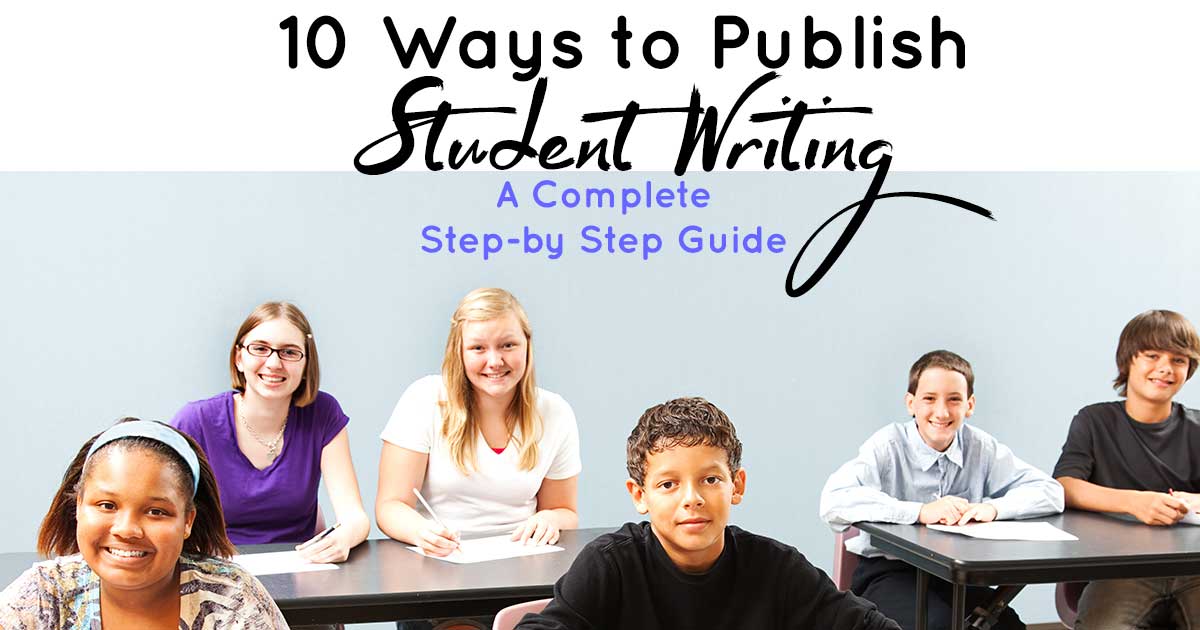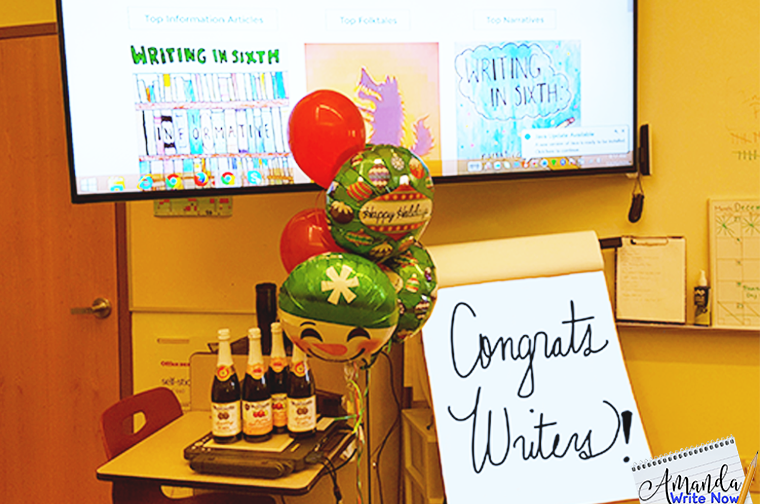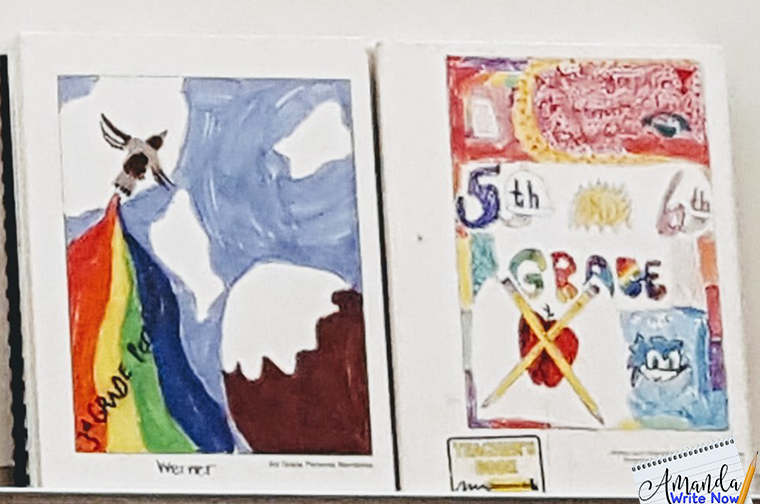
Publishing student writing is the cornerstone of a successful writing workshop program. At the beginning of each of my writing units I tell students they will write many different drafts within a writing genre and pick one to revise intensely and then to publish.
In this article I’ll present many options for publishing student writing, materials you’ll need, the steps you need to take in order to implement these options and the best resources I’ve found to support you in sharing your students’ writing with the world!
Host a Publishing Party
Materials:
- Large area such as a gym or multipurpose room
- Invitation email to other classes, parents and administrators
- Handwritten author bio on notecard
- Printed student writing pieces
- Students in pairs
- Card stock numbered 1-12, each pair will sit in front of their numbered card stock sign
- Post-its numbered 1-12, duplicate these numbered post-its so that pairs of student guests from other classes meet with pairs of your students
Steps:
1. Pick a date.
2. Craft an email invitation.
3. Launch your writing unit, explaining the date and publishing party to students.
4. Allow your students to write and write and write for about two weeks straight.
5. Have students pick one piece they want to revise A LOT, teach revising & editing strategies.
6. Allow students to work with writing partners A LOT.
7. Have students write their author bio, use sample author bios from publish books as mentor texts.
8. Have students print their published piece.
Optional: get sparkling cider and balloons to build even more excitement for the event!
9. Have pairs of your students sit in front of numbered card stock signs with their author bios and printed published pieces in front of them.
10. As student guests walk in, hand them a post-it which tells them where to go.
11. Your students will read their author bio and summarize their writing pieces to student guests.
12. After about 5-6 minutes give the signal to rotate to the next consecutive number, you may want to explain this to guest classes and teachers beforehand.
Resources:
8 Tips for a Great Publishing Party
Beyond the Publishing Party: Ten Ways to Celebrate Learning
Create a Class E-Book
Materials:
- PowerPoint or Google Slides
- Typed student writing pieces
Steps:
1. Change the layout of your PowerPoint or Google Slides to 8.5×11 inches, see Cult of Pedagogy’s video above for how to do this using PowerPoint. The process is pretty much the same in Google Slides.
2. Design your cover or have a student design it using PowerPoint or Google Slides. Use the same 8.5×11 inch size.
3. Copy and paste typed writing pieces into each slide or have a responsible student do this.
4. Save all the work as a PowerPoint document or in a safe place in your Google Drive if you’re using Google Slides.
5. Save your slides as a PDF. You can do this in PowerPoint and in Google Slides.
6. Share the PDF E-Book online or in an email to parents, admin and the school.
Resources:
How to Create an E-Book from Start to Finish
Host a Book Store Event
Materials:
- Contact a local book store
- Student writing pieces printed, bound
- Optional: covers laminated
- Handwritten author bio on notecard
- Invitations to parents, other classes, teachers and administrators
Steps:
1. Contact your local book store and explain what you’d like to do and decide on a date to host your event, be sure to ask for a good chunk of time such as four hours so students and their parents can come and go within that time frame.
2. Craft an email invitation to parents, admin and possibly other classes.
3. Launch your writing unit, explaining the date and book store event to students.
4. Allow your students to write and write and write for about two weeks straight.
5. Have students pick one piece they want to revise A LOT.
6. Teach revising strategies, allow students to peer conference and teach editing strategies.
7. Have students write their author bio, use sample author bios from publish books as mentors.
8. Have students print their published piece and create covers.
9. If possible, laminate covers and bind books or just staple them together.
10. Let students know they are required to come to the event within the scheduled time frame.
11. Make sure to take pictures to share with the school, on your class website and on social media!
Resources:
Third Grade Authors Celebrate with Special Bookstore Reading Night
Create a Hardback Book
Materials:
- Contact one or all of the following companies to find out necessary steps and publishing dates: Schoolmate Publishing, Student Treasures, Classroom Authors, LuLu Jr., Blurb
- Parent permission forms (usually provided by companies above)
- Student writing pieces either handwritten or typed in format provided by company
Steps:
1. Contact your chosen company above, at least three months in advance to allow time for the company to send you the necessary materials.
2. Once you receive your materials launch your writing unit, making sure to show students the publishing kit you received in the mail!
3. As always, allow students lots of time to produce lots and lots of drafts, revise and edit their work before using the materials provided in the kit.
4. Make sure to read through all the instructions in your kit, send home any letters or stickers required by the company.
5. Once students have handwritten or typed their writing using the kit directions mail it in.
6. On the day your book(s) arrives celebrate with a popcorn party, read-a-thon/read-aloud-a-thon!
Resources:
Publish Online
Materials:
- Sign up for a gmail account if you want to use Google Sites
- Sign up for a Weebly account if you plan to use Weebly
- Parent & student permission forms signed and dated
Steps:
1. Launch your writing unit explaining the goal of publishing writing pieces on a class website.
2. Allow students lots of time to handwrite lists and drafts in their writing notebook.
3. After about two weeks, have students pick one piece to type, revise and edit.
4. Have students share their typed piece either via Google Classroom or email.
5. Copy and paste each piece as a link on your website (this can be very time consuming so you might want to ask a parent or responsible student volunteer for help.
6. In order to cut back on the amount of work this requires, you could also only publish “top writers” pieces.
7. Share the website with parents, admin and other classes via a link in an email.
Resources:
Publish in Google Classroom
Materials:
- Gmail account
- Google Classroom
Steps:
1. Launch your writing unit explaining the goal of publishing pieces in Google Classroom for other classmates and even other classes (if you are a middle or high school teacher with multiple sections).
2. Allow students lots of time to handwrite lists and drafts in their writing notebook.
3. After about two weeks of lots of notebook writing, have students pick one piece to type, revise and edit.
4. Create a Google Classroom assignment called, “My Published__________________”insert whatever genre your students are writing within, add a blank Google Doc and make a copy for each student. Have students type the piece they want to publish in this Google Classroom Doc.
5. Create another assignment called, “Class Published_________________”, again insert whatever genre, this time add a blank Google Doc that all students can edit.
6. Have groups of four students take turns adding a link to their published piece into the shared Google Doc.
7. Spend a few days allowing students to click links, read each others’ pieces and write comments.
Resources:
Participate in Writing Contests
Materials:
- Visit these potential contest sites: Creative Communications, Nanowrimo, New York Times Learning Network
Steps:
1. Visit one of the websites above, my favorite is Creative Communications because of the simple rules to follow, the samples of winning writing provided and I’ve had students win before!
2. Read through the rules, usually there is some sort of permission slip to send home with students.
3. Show any videos that describe the contest to students. Read any rules and directions out loud to students.
4. Give students lots and lots of time to draft in class.
5. Allow time for students to read their writing piece aloud to a peer and get editing help.
6. Follow submission rules for the contest.
7. Celebrate students’ hard work and submissions with sparkling cider and popcorn and a reading of the pieces!
Resources:
Imagination Soup-Writing Contests for Kids
Use Publishing Apps
Materials:
- Learn about one or all of the possible apps you can use to publish work: Storybird, Flipsnack, PowToon, My Simple Show
- iPad, Chromebooks, computers depending on the app you are using
Steps:
1. Learn the app you plan to use with your students, try publishing your own piece of writing using the app first.
2. Launch your writing unit by showing tutorial videos about the app you plan to use with students. Ask students if they have experience with the app and would be willing to help others in the class use it. You aren’t the only teacher in the room!
3. Allow students time to brainstorm, list and draft BEFORE letting them use the app.
4. After students have shown you their drafts, plans and revised their writing, allow them time to play with the app to get used to the way it works.
5. Link student work in an, editable by all students, shared Google Classroom Doc (see Google Classroom video for how to do this).
6. Allow students a few days to watch and read each others’ creations!
7. Serve a treat or allow students to bring their own to make it an even more exciting event!
Resources:
5 Best Free Educational Tools for Publishing Student Writing
8 Powerful Apps to Help You Create Books on the iPad
Publish with E-Portfolios
Materials:
- Student Gmail Accounts
- Access to Google Sites
Steps:
1. At the beginning of the year, explain to students that an E-Portfolio is an electronic portfolio of a student’s best work displayed via a webpage.
2. Every time a student produces a piece of writing they feel proud of or has gone through the drafting, revising and editing process make sure they insert it into their E-Portfolio.
3. Have students share links to their E-Portfolios via Google Classroom in a shared, editable doc.
4. Each month allow students time to visit each others’ E-Portfolios to read what others have written and included.
Resources:
Which e-portfolio tool is right for you?
Host a Poetry Slam
- Large area such as a gym or multipurpose room
- Invitation email to other classes, parents and administrators
- Optional: podium, lamps, couches, bean bag chairs, refreshments
Steps:
1. Contact admin or janitorial staff to schedule a large space in your school or use your classroom
2. Launch your writing unit beginning with a description of what a poetry slam is. Below you’ll find resources to that explain in depth the history of poetry slams.
3. Read, watch and analyze lots of slam poetry readings.
4. Allow students to emulate the poems and write for a couple weeks straight.
5. Always allow students the opportunity to perform their poems at the end of the workshop hour. This will be great practice for the poetry slam event!
6. Have students pick one poem from all the poems they wrote over the course of two weeks to revise, reread, change and recite over and over until the day of the poetry slam.
7. Create a poetry slam program or have a trusted student take on this project.
8. Recruit student volunteers to greet guests and hand out programs.
9. Soak up the beauty of community, creativity and poetry.
Resources:
Students Showcase Writing Talents at Poetry Reading
Wrap Up…
English classes have changed dramatically in the last ten to twenty years. Students need audiences for their writing beyond their teacher. Publishing student work for the world to see is a must if you plan to run a successful, motivating and engaging writing workshop program!






Thank you Amanda! I teach a college course on writing instruction Pre-K-4 and always send my students to your post for my class on publishing!
That’s so awesome Christin! Thank you for taking the time to leave a comment and share this with me:) It makes all the hard work worth it, knowing that I’m helping others!